Beko DN136110, DN136110M, DN137103, DN133100, DN133100S User manual [EN,FR,AR,RU]
...
DN136110
DN136110M
DN137103
DN133100
DN133100S
DN137103T
Refrigerator
Réfrigérateur
Холодильник

Please read this manual first!
Dear Customer,
We hope that your product, which has been produced in modern plants and checked under the most meticulous quality control procedures, will provide you an effective service.
For this, we recommend you to carefully read the entire manual of your product before using it and keep it at hand for future references.
This manual
•Will help you use your appliance in a fast and safe way.
•Read the manual before installing and operating your product.
•Follow the instructions, especially those for safety.
•Keep the manual in an easily accessible place as you may need it later.
•Besides, read also the other documents provided with your product.
Please note that this manual may be valid for other models as well.
Symbols and their descriptions
This instruction manual contains the following symbols:
C Important information or useful usage tips.
AWarning against dangerous conditions for life and property.
BWarning against electric voltage.
This product is supplied with the selective sorting symbol for waste electrical Recycling and electronic equipment (WEEE).
This means that this product must be handled pursuant to European Directive 2002/96/EC in order to be recycled or dismantled to minimise its impact on the environment. For further information, please contact your local or regional authorities.
Electronic products not included in the selective sorting process are potentially dangerous for the environment and human health due to the presence of hazardous substances.

CONTENTS
Your refrigerator |
3 |
2 Important Safety Warnings4
Intended use...................................... |
4 |
For products with a water dispenser;. 6 |
|
Child safety........................................ |
6 |
HCA Warning..................................... |
6 |
Things to be done for energy saving... |
7 |
Recommendations for freshfood |
|
compartment..................................... |
7 |
3 Installation |
8 |
Points to be considered when re- |
|
transporting your refrigerator.............. |
8 |
Before operating your refrigerator....... |
8 |
Disposing of the packaging................ |
9 |
Disposing of your old refrigerator........ |
9 |
Placing and Installation....................... |
9 |
Changing the illumination lamp .......... |
9 |
Adjusting the feet............................... |
9 |
4 Preparation |
10 |
Reversing the doors......................... |
11 |
5 Using your refrigerator 12 |
|
Fridge compartment temperature |
|
setting button .................................. |
12 |
Freezer compartment temperature |
|
setting button .................................. |
13 |
Making ice........................................ |
13 |
Freezing fresh food........................... |
14 |
Recommendations for preservation of |
|
frozen food....................................... |
14 |
Placing the food............................... |
14 |
Deep-freeze information................... |
15 |
Crisper humidity control sliders......... |
16 |
Using the rotary crisper (in some |
|
models)............................................ |
16 |
6 Maintenance and |
|
cleaning |
17 |
Protection of plastic surfaces .......... |
17 |
7 Recommended solutions |
|
for the problems |
18 |
2EN

1 Your refrigerator
141  *2
*2 











3 


*4 
5 
4 


154
6
*7
*8
9
10 *13 11 *12
12
*12
*13
1- |
Freezer compartment shelf |
8- |
Crisper |
|
9- |
Adjustable legs |
|||
2- |
Ice container |
|||
10Freezer compartment door shelf |
||||
3- |
Fridge compartment temperature |
|||
11- |
Egg tray |
|||
setting button |
||||
12Fridge compartment door shelf |
||||
4- |
Adjustable body shelves |
|||
13- |
Key |
|||
5- |
Illumination lens |
|||
14- |
Freezer compartment |
|||
6- |
Crisper cover |
|||
15- |
Fridge compartment |
|||
7- |
Crisper humidity control slider |
|||
|
|
|||
* OPTIONAL
Figures that take place in this instruction manual are schematic and may not correspond exactly with your product. If the subject parts are not included in the product you have purchased, then it is valid for other models.
3EN

2 Important Safety Warnings
Please review the following information. Failure to observe this information may cause injuries or material damage. Otherwise, all warranty and reliability commitments will become invalid.
The usage life of the unit you purchased is 10 years. This is the period for keeping the spare parts required for the unit to operate as described.
Intended use
This product is intended to be used
–indoors and in closed areas such as homes;
–in closed working environments such as stores and offices;
–in closed accommodation areas such as farm houses, hotels, pensions.
• This product should not be used outdoors.
General safety
•When you want to dispose/scrap the product, we recommend you to consult the authorized service in
order to learn the required information and authorized bodies.
•Consult your authorized service for all your questions and problems related to the refrigerator. Do not intervene or let someone intervene to the refrigerator without notifying the authorised services.
•For products with a freezer compartment; Do not eat cone ice cream and ice cubes immediately after you take them out of the freezer compartment! (This may cause frostbite in your mouth.)
•For products with a freezer compartment; Do not put bottled and canned liquid beverages in the freezer compartment. Otherwise, these may burst.
•Do not touch frozen food by hand; they may stick to your hand.
•Unplug your refrigerator before cleaning or defrosting.
•Vapor and vaporized cleaning materials should never be used in cleaning and defrosting processes of your refrigerator. In such cases, the vapor may get in contact with the electrical parts and cause short circuit or electric shock.
•Never use the parts on your refrigerator such as the door as a means of support or step.
•Do not use electrical devices inside the refrigerator.
•Do not damage the parts, where the refrigerant is circulating, with drilling or cutting tools. The refrigerant that might blow out when the gas channels of the evaporator, pipe extensions or surface coatings are punctured causes skin irritations and eye injuries.
•Do not cover or block the ventilation holes on your refrigerator with any material.
•Electrical devices must be repaired by only authorised persons. Repairs performed by incompetent persons create a risk for the user.
•In case of any failure or during a maintenance or repair work,
disconnect your refrigerator’s mains supply by either turning off the relevant fuse or unplugging your appliance.
4EN

•Do not pull by the cable when pulling off the plug.
•Place the beverage with higher proofs tightly closed and vertically.
•Never store spray cans containing flammable and explosive substances in the refrigerator.
•Do not use mechanical devices or other means to accelerate the
defrosting process, other than those recommended by the manufacturer.
•This product is not intended to be used by persons with physical, sensory or mental disorders or unlearned or inexperienced people (including children) unless they are attended by a person who will be responsible for their safety or who will instruct them accordingly for use of the product
•Do not operate a damaged refrigerator. Consult with the service agent if you have any concerns.
•Electrical safety of your refrigerator shall be guaranteed only if the earth system in your house complies with standards.
•Exposing the product to rain, snow, sun and wind is dangerous with respect to electrical safety.
•Contact authorized service when there is a power cable damage to avoid danger.
•Never plug the refrigerator into the wall outlet during installation. Otherwise, risk of death or serious injury may arise.
•This refrigerator is intended for only storing food items. It must not be used for any other purpose.
•Label of technical specifications is located on the left wall inside the refrigerator.
•Never connect your refrigerator to electricity-saving systems; they may damage the refrigerator.
•If there is a blue light on the refrigerator, do not look at the blue light with optical tools.
•For manually controlled refrigerators, wait for at least 5 minutes to start the refrigerator after power failure.
•This operation manual should be handed in to the new owner of the product when it is given to others.
•Avoid causing damage on power cable when transporting the refrigerator. Bending cable may cause fire. Never place heavy objects on power cable. Do not touch the plug with wet hands when plugging the product.
•Do not plug the refrigerator if the wall outlet is loose.
•Water should not be sprayed directly on inner or outer parts of the product for safety purposes.
•Do not spray substances containing inflammable gases such as propane gas near the refrigerator to avoid fire and explosion risk.
•Never place containers filled with water on top of the refrigerator, otherwise this may cause electric shock or fire.
•Do not overload your refrigerator with excessive amounts of food. If overloaded, the food items may fall
5EN

down and hurt you and damage refrigerator when you open the door.
Never place objects on top of the refrigerator; otherwise, these objects may fall down when you open or close the refrigerator's door.
•As they require a precise temperature, vaccines, heat-sensitive medicine and scientific materials and etc. should not be kept in the refrigerator.
•If not to be used for a long time, refrigerator should be unplugged. A possible problem in power cable may cause fire.
•The plug's tip should be regularly cleaned; otherwise, it may cause fire.
•The plug’s tip should be cleaned regularly with a dry cloth; otherwise, it may cause fire.
•Refrigerator may move if adjustable legs are not properly secured on the floor. Properly securing adjustable legs on the floor can prevent the refrigerator to move.
•When carrying the refrigerator, do not hold it from door handle. Otherwise, it may be snapped.
•When you have to place your product next to another refrigerator or freezer, the distance between devices should be at least 8cm. Otherwise, adjacent side walls may be humidified.
For products with a water dispenser;
Pressure of water mains should be minimum 1 bar. Pressure of water mains should be maximum 8 bars.
• Use only potable water.
Child safety
•If the door has a lock, the key should be kept away from reach of children.
•Children must be supervised to prevent them from tampering with the product.
HCA Warning
If your product's cooling system contains R600a:
This gas is flammable. Therefore, pay attention to not damaging the cooling system and piping during usage and transportation. In the event of damage, keep your product away from potential fire sources that can cause the product catch a fire and ventilate the room in which the unit is placed.
Ignore this warning if your product's cooling system contains R134a.
Type of gas used in the product is stated in the type plate which is on the left wall inside the refrigerator.
Never throw the product in fire for disposal.
6EN

Things to be done for energy saving
•Do not leave the doors of your refrigerator open for a long time.
•Do not put hot food or drinks in your refrigerator.
•Do not overload your refrigerator so that the air circulation inside of it is not prevented.
•Do not install your refrigerator under direct sunlight or near heat emitting appliances such as ovens, dishwashers or radiators.
•Pay attention to keep your food in closed containers.
•For products with a freezer compartment; You can store maximum amount of food items in the freezer when you remove the shelf or drawer of the freezer. Energy consumption value stated for your refrigerator has been determined
by removing freezer shelf or drawer and under maximum load. There is no harm to use a shelf or drawer
according to the shapes and size of food to be frozen.
•Thawing frozen food in fridge compartment will both provide energy saving and preserve the food quality.
Recommendations for freshfood compartment
* OPTIONAL
•Please do not let any foodstuff to come to contact with the temperature sensor in freshfood compartment.
In order to maintain freshfood compartment at ideal storage temperature, the sensor must not be blocked by fodstuffs.
•Do not place hot foodstuff in your appliance.
food |
temperature |
sensor |
MILK |
temperature |
juice |
|
etc. |
sensor |
|
7EN
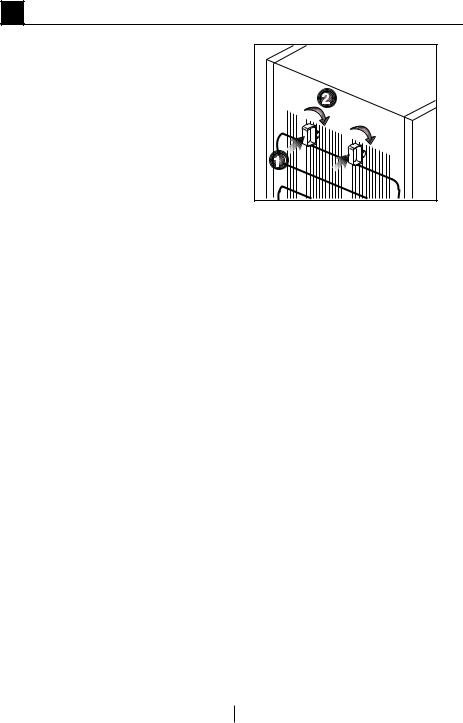
3 Installation
B Please remember that the manufacturer shall not be held liable if the information given in the
instruction manual is not observed.
Points to be considered when re-transporting your refrigerator
1.Your refrigerator must be emptied and cleaned prior to any transportation.
2.Shelves, accessories, crisper and etc. in your refrigerator must be fastened securely by adhesive tape against any jolt before repackaging.
3.Packaging must be tied with thick tapes and strong ropes and the rules of transportation printed on the package must be followed.
Please do not forget…
Every recycled material is an indispensable source for the nature and for our national resources.
If you wish to contribute to recycling the packaging materials, you can get further information from the environmental bodies or local authorities.
Before operating your refrigerator
Before starting to use your refrigerator check the following:
1.Is the interior of the refrigerator dry and can the air circulate freely in the rear of it?
2.You can install the 2 plastic wedges as illustrated in the figure. Plastic wedges will provide the required distance between your refrigerator
and the wall in order to allow the air circulation. (The illustrated figure is only an example and does not match
exactly with your product.) |
8 |
3.Clean the interior of the refrigerator as recommended in the “Maintenance and cleaning” section.
4.Plug the refrigerator into the wall outlet. When the fridge door is open the fridge compartment interior light will come on.
5.You will hear a noise as the compressor starts up. The liquid and gases sealed within the refrigeration system may also give rise to noise, even if the compressor is not running and this is quite normal.
6.Front edges of the refrigerator may feel warm. This is normal. These areas are designed to be warm to avoid condensation.
Electric connection
Connect your product to a grounded socket which is being protected by a fuse with the appropriate capacity.
Important:
•The connection must be in compliance with national regulations.
•The power cable plug must be easily accessible after installation.
•The specified voltage must be equal to your mains voltage.
EN

•Extension cables and multiway plugs must not be used for connection.
B A damaged power cable must be replaced by a qualified electrician.
B Product must not be operated before it is repaired! There is danger of
electric shock!
Disposing of the packaging
The packing materials may be dangerous for children. Keep the packing materials out of the reach of children or dispose them of by classifying them in accordance with the waste instructions. Do not
dispose them of along with the normal household waste.
The packing of your refrigerator is produced from recyclable materials.
Disposing of your old refrigerator
Dispose of your old machine without giving any harm to the environment.
• You may consult your authorized dealer or waste collection center of your municipality about the disposal of your refrigerator.
Before disposing of your refrigerator, cut out the electric plug and, if there are any locks on the door, make them inoperable in order to protect children against any danger.
Changing the illumination lamp
To change the lamp used for illumination of your refrigerator, please call your Authorized Service.
Placing and Installation
1.Install your refrigerator to a place that allows ease of use.
2.Keep your refrigerator away from heat sources, humid places and direct sunlight.
3.There must be appropriate air ventilation around your refrigerator in order to achieve an efficient operation.
If the refrigerator is to be placed in a recess in the wall, there must be at least 5 cm distance with the ceiling and at least 5 cm with the wall.
If the floor is covered with a carpet, your product must be elevated 2.5 cm from the floor.
4. Place your refrigerator on an even floor surface to prevent jolts.
Adjusting the feet
If your refrigerator is unbalanced;
You can balance your refrigerator by turning the front legs as shown in the illustration below. The corner where the leg exists is lowered when you turn it in the direction of black arrow and raised when you turn in the opposite direction. Taking help from someone to slightly lift the refrigerator will facilitate this process.
9EN

4 Preparation
CYour refrigerator should be installed at least 30 cm away from heat sources such as hobs, ovens, central heater and stoves and at least 5 cm away from electrical ovens and should not be located under direct sunlight.
CPlease make sure that the interior of your refrigerator is cleaned thoroughly.
CIf two refrigerators are to be installed side by side, there should be at least 2 cm distance between them.
CWhen you operate your refrigerator for the first time, please observe the following instructions during the initial six hours.
-The door should not be opened frequently.
-It must be operated empty without any food in it.
-Do not unplug your refrigerator. If a power failure occurs out of your control, please see the warnings in the “Recommended solutions for the problems” section.
COriginal packaging and foam materials should be kept for future transportations or moving.
CThis appliance is designed to operate at temperatures specified in the table below is equipped with Advanced Electronic Temperature Control System [AETCS] which ensures that at the advised setting [4 - four on the knob] the frozen food in the freezer will not defrost even if the ambient temperature falls as low as -15 °C. When first installed the product
MUST NOT be placed in low ambient temperatures because the freezer will not reduce to it’s standard operating temperature. Once it has reached
its steady operating state it can be re-located. So you may then install your appliance in a garage or an unheated room without having to worry about frozen food in the freezer being spoilt. However at low ambient temperatures mentioned above, fridge contents are likely to freeze, so check and consume food in the fridge accordingly. When the ambient temperature returns to normal, you may change the knob setting to suit your needs.
CIf the ambient temperature is below 0°C, the food in the fridge compartment will freeze.So, we
recommend you don’t use the fridge compartment in such low ambient conditions. You can continue using the freezer compartment as usual.
10 EN
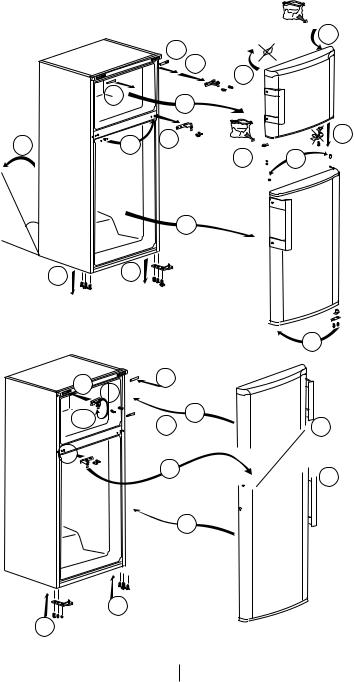
Reversing the doors
Proceed in numerical order .
4 5
7
45°
8
18
180°
23
15 

4
17
16
2
61
3
9
19
 19 22
19 22
21
20
 10
10
10
11
12 
 13
13
14
 24
24
 24
24
11 EN

5 Using your refrigerator
Fridge compartment temperature setting button
Temperature button allows you to make the general temperature setting of your refrigerator.
Temperature button of the refrigerator controls both the temperature
of the freezer compartment and the amount of the air send to the fridge compartment and thus, the temperature of the fridge compartment.
At regular room temperatures:
Set the temperature button to a position between “2 and 3” to store your food.
5 |
4 |
3 |
At high room temperatures:
Temperature button must be set to a cooler position if the food is going to be frozen or large amounts of food will be loaded.
If the food in the fridge compartment
cools too much or freezes, temperature button must be set to position “1”.
If the fridge compartment is colder then the required 24 hours after the initial startup, open the lower door and turn the fridge compartment temperature setting button towards to the position “1” and if it is warmer then the required, slightly turn it towards to the position “5”.
12 EN

Freezer compartment temperature setting button
Freezer compartment setting button can be set to a position between
Normal and Quick Freezing.
•In Normal position, the amount of the air sent to the fridge compartment reaches to maximum.
•In Quick Freezing position, the amount of the air sent to the freezer compartment reaches to maximum. And the amount of the air sent to the fridge compartment decreases to minimum. In this case, the temperature of the fridge compartment will increase. This is normal.
•If you do not need more cooling in either of the compartments, leave the setting button in Normal position.
•In cases where the room temperature is high (25 °C and above), it is suggested to set the freezer compartment setting button to a position near the Normal.
•In low room temperatures, it is suggested to set the freezer
compartment setting button to a position between the Normal and Quick Freezing.
Making ice
Fill the ice container with water and place it into its seat. Your ice will be ready approximately in two hours.
You can easily remove your ice by slightly twisting the ice container.
13 |
EN |

Freezing fresh food
•It must be preferred to wrap or cover the food before placing them in the refrigerator.
•Hot food must cool down to the room temperature before putting them in the refrigerator.
•The foodstuff that you want to freeze must be fresh and in good quality.
•Foodstuff must be divided into portions according to the family’s daily or meal based consumption needs.
•The foodstuff must be packaged in an airtight manner to prevent them from drying even if they are going to be kept for a short time.
•Materials to be used for packaging must be tear-proof and resistant to cold, humidity, odor, oils and acids and they must also be airtight.
Moreover, they must be well closed and they must be made from easy- to-use materials that are suitable for deep freeze usage.
•Frozen food must be used immediately after they are thawed and they should never be re-frozen.
•Please observe the following instructions to obtain the best results.
1.Do not freeze too large quantities of food at one time. The quality of the food is best preserved when it is frozen right through to the core as quickly as possible.
2.Placing warm food into the freezer compartment causes the cooling system to operate continuously until the food is frozen solid.
3.Take special care not to mix already frozen food and fresh food.
Recommendations for preservation of frozen food
•Prepacked commercially frozen food should be stored in accordance with the frozen food manufacturer's instructions for a  ( 4 star) frozen food storage compartment.
( 4 star) frozen food storage compartment.
•To ensure that the high quality achieved by the frozen food manufacturer and the food retailer is maintained, the following should be remembered:
1.Put packages in the freezer as quickly as possible after purchase.
2.Ensure that contents are labeled and dated.
3.Do not exceed "Use By", "Best Before" dates on the packaging.
Defrosting
The freezer compartment defrosts automatically.
Placing the food
|
|
|
|
Various frozen |
|
Freezer |
food such as |
|
compartment |
meat, fish, ice |
|
shelves |
cream, vegetables |
|
|
and etc. |
|
Egg tray |
Egg |
|
|
|
|
Fridge |
Food in pans, |
|
covered plates |
||
compartment |
||
and closed |
||
shelves |
||
containers |
||
|
||
|
|
|
|
Small and |
|
Fridge |
packaged food |
|
compartment |
or drinks (such as |
|
door shelves |
milk, fruit juice and |
|
|
beer) |
|
Crisper |
Vegetables and |
|
fruits |
||
|
||
|
|
|
|
Delicatessen |
|
Freshzone |
products (cheese, |
|
compartment |
butter, salami and |
|
|
etc.) |
14 EN

Deep-freeze information
Food must be frozen as rapidly as possible when they are p
ut in a refrigerator in order to keep them in good quality.
The TSE norm requires (according to certain measurement conditions) the refrigerator to freeze at least 4.5 kg of foodstuff at 32°C ambient temperature to -18°C or lower within 24 hours for every 100-liters of freezer volume.
It is possible to keep the food for a long time only at -18°C or lower temperatures.
You can keep the freshness of food for many months (at -18°C or lower temperatures in the deep freeze).
WARNING! A
•Foodstuff must be divided into portions according to the family’s daily or meal based consumption needs.
•Foodstuff must be packaged in an airtight manner to prevent them from drying even if they are going to be kept for a short time.
Materials necessary for packaging:
•Cold resistant adhesive tape
•Self adhesive label
•Rubber rings
•Pen
Materials to be used for packaging the foodstuff must be tear-proof and resistant to cold, humidity, odor, oils and acids.
Foodstuff to be frozen should not be allowed to come in contact with the previously frozen items to prevent their partial thawing.
Frozen food must be used immediately after they are thawed and they should never be re-frozen.
15 EN
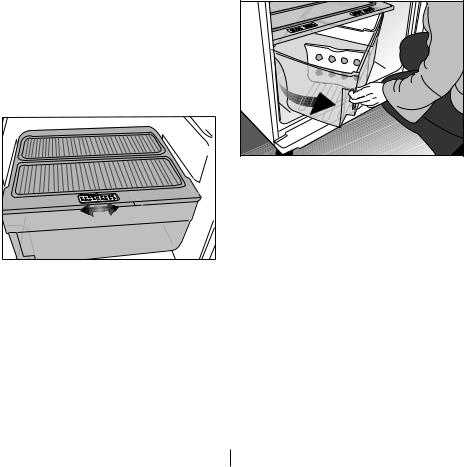
Crisper humidity control sliders
Using the crisper humidity control sliders
Crisper of your refrigerator is designed specially to keep your vegetables fresh without loosing their humidity. Cold air circulates basically around the crisper and the amount of the cold air passing through the crisper is controlled by the sliders on the front side of the crisper cover.
You can adjust the humidity control sliders to a suitable position according to the humidity and cooling condition of your food in the crisper.
If you want your food in the crisper to cool more, open the holes of the humidity control sliders and if you want them to cool less and keep their humidity for a longer time, close the holes.
Using the rotary crisper (in some models)
The crisper of your refrigerator which opens with a rotating movement is designed specially to provide ease of usage and allow you to store more vegetables and fruits (large volume) you buy during large shopping.
When you grab and pull the handle on the lower left hand side of the crisper, it will rotate from left to right and open easily. The separator in the crisper will allow you to separate the vegetables and fruits according to their types and prevent them from crushing.
16 EN

6 Maintenance and cleaning
A Never use gasoline, benzene or similar substances for cleaning purposes.
B We recommend that you unplug the appliance before cleaning.
B Never use any sharp abrasive instrument, soap, household cleaner, detergent and wax polish for cleaning.
CUse lukewarm water to clean the cabinet of your refrigerator and wipe it dry.
CUse a damp cloth wrung out in a solution of one teaspoon of
bicarbonate of soda to one pint of water to clean the interior and wipe it dry.
B Make sure that no water enters the lamp housing and other electrical items.
B If your refrigerator is not going to be used for a long period of time, unplug the power cable, remove all food, clean it and leave the door ajar.
CCheck door seals regularly to ensure they are clean and free from food particles.
A To remove door racks, remove all the contents and then simply push the door rack upwards from the base.
Protection of plastic surfaces
CDo not put the liquid oils or oil-cooked meals in your refrigerator in unsealed containers as they damage the plastic surfaces of your refrigerator. In case of spilling or smearing oil on the plastic surfaces, clean and rinse the relevant part of the surface at once with warm water.
17 EN

7 Recommended solutions for the problems
Please review this list before calling the service. It might save you time and money. This list includes frequent complaints that are not arising from defective workmanship or material usage. Some of the features described here may not exist in your product.
The refrigerator does not operate.
•Is the refrigerator properly plugged in? Insert the plug to the wall socket.
•Is the fuse of the socket which your refrigerator is connected to or the main fuse blown out? Check the fuse.
Condensation on the side wall of the fridge compartment (MULTIZONE, COOL CONTROL and FLEXI ZONE).
•Very cold ambient conditions. Frequent opening and closing of the door. Highly humid ambient conditions. Storage of food containing liquid in open containers.
Leaving the door ajar. Switching the thermostat to a colder degree.
•Decreasing the time the door left open or using it less frequently.
•Covering the food stored in open containers with a suitable material.
•Wipe the condensation using a dry cloth and check if it persists.
Compressor is not running
•Protective thermic of the compressor will blow out during sudden power failures or plug-out plug-ins as the refrigerant pressure in the cooling system of the refrigerator has not been balanced yet. Your refrigerator will start running approximately after 6 minutes. Please call the service if the refrigerator does not startup at the end of this period.
•The fridge is in defrost cycle. This is normal for a full-automatically defrosting refrigerator. Defrosting cycle occurs periodically.
•Your refrigerator is not plugged into the socket. Make sure that the plug is properly fit into the socket.
•Are the temperature adjustments correctly made?
•Power might be cut off.
The fridge is running frequently or for a long time.
18 EN
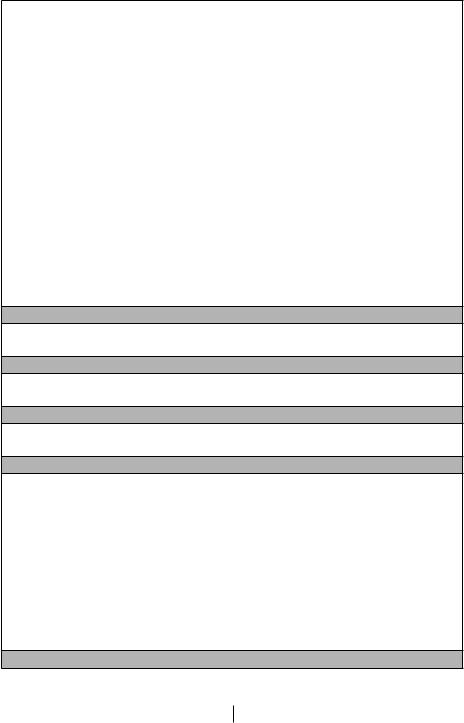
•Your new product may be wider than the previous one. This is quite normal. Large refrigerators operate for a longer period of time.
•The ambient room temperature may be high. This is quite normal.
•The refrigerator might have been plugged in recently or might have been loaded with food. Cooling down of the refrigerator completely may last for a couple of hours longer.
•Large amounts of hot food might have been put in the refrigerator recently. Hot food causes longer running of the refrigerator until they reach the safe storage temperature.
•Doors might have been opened frequently or left ajar for a long time. The warm air that has entered into the refrigerator causes the refrigerator to run for longer periods. Open the doors less frequently.
•Freezer or fridge compartment door might have been left ajar. Check if the doors are tightly closed.
•The refrigerator is adjusted to a very low temperature. Adjust the refrigerator temperature to a warmer degree and wait until the temperature is achieved.
•Door seal of the fridge or freezer may be soiled, worn out, broken or not properly seated. Clean or replace the seal. Damaged/broken seal causes the refrigerator to run for a longer period of time in order to maintain the current temperature.
Freezer temperature is very low while the fridge temperature is sufficient.
•The freezer temperature is adjusted to a very low temperature. Adjust the freezer temperature to a warmer degree and check.
Fridge temperature is very low while the freezer temperature is sufficient.
•The fridge temperature might have been adjusted to a very low temperature.
Adjust the fridge temperature to a warmer degree and check.
Food kept in the fridge compartment drawers are freezing.
•The fridge temperature might have been adjusted to a very low temperature.
Adjust the fridge temperature to a warmer degree and check.
Temperature in the fridge or freezer is very high.
•The fridge temperature might have been adjusted to a very high degree.
Fridge adjustment has an effect on the temperature of the freezer. Change the temperature of the fridge or freezer until the fridge or freezer temperature reaches to a sufficient level.
•Doors might have been opened frequently or left ajar for a long time; open them less frequently.
•Door might have been left ajar; close the door completely.
•Large amount of hot food might have been put in the refrigerator recently. Wait until the fridge or freezer reaches the desired temperature.
•The refrigerator might have been plugged in recently. Cooling down of the refrigerator completely takes time.
The operation noise increases when the refrigerator is running.
19 EN

•The operating performance of the refrigerator may change due to the changes in the ambient temperature. It is normal and not a fault.
Vibrations or noise.
•The floor is not even or it is weak. The refrigerator rocks when moved slowly.
Make sure that the floor is strong enough to carry the refrigerator, and level.
•The noise may be caused by the items put onto the refrigerator. Items on top of the refrigerator should be removed.
There are noises coming from the refrigerator like liquid spilling or spraying.
•Liquid and gas flows happen in accordance with the operating principles of your refrigerator. It is normal and not a fault.
There is a noise like wind blowing.
•Fans are used in order to cool the refrigerator. It is normal and not a fault.
Condensation on the inner walls of refrigerator.
•Hot and humid weather increases icing and condensation. It is normal and not a fault.
•Doors might have been left ajar; make sure that the doors are closed fully.
•Doors might have been opened frequently or left ajar for a long time; open them less frequently.
Humidity occurs on the outside of the refrigerator or between the doors.
•There might be humidity in the air; this is quite normal in humid weather. When the humidity is less, condensation will disappear.
Bad odour inside the refrigerator.
•Inside of the refrigerator must be cleaned. Clean the inside of the refrigerator with a sponge, lukewarm water or carbonated water.
•Some containers or package materials might cause the smell. Use a different container or different brand packaging material.
The door is not closing.
•Food packages may prevent the door's closing. Replace the packages that are obstructing the door.
•The refrigerator is not completely upright on the floor and rocking when slightly moved. Adjust the elevation screws.
•The floor is not level or strong. Make sure that the floor is level and capable to carry the refrigerator.
Crispers are stuck.
•The food might be touching the ceiling of the drawer. Rearrange food in the drawer.
20 EN

Veuillez d’abord lire la notice d’utilisation !
Chère cliente, cher client,
Nous espérons que votre produit, qui a été fabriqué dans des usines modernes et vérifié au terme des procédures de contrôle de qualité les plus méticuleuses, vous aidera efficacement.
Pour cette raison, nous vous conseillons de lire attentivement tout le manuel d’utilisation de votre produit avant de vous en servir, et de le conserver ensuite pour une utilisation ultérieure.
Le présent manuel
•vous aidera à utiliser votre produit avec rapidité et sécurité.
•Lisez le manuel avant d’installer et de faire fonctionner votre produit.
•Respectez les instructions, notamment celles relatives à la sécurité.
•Conservez ce manuel dans un endroit facilement accessible car vous Pourriez en avoir besoin ultérieurement.
•En plus, lisez également les autres documents fournis avec votre produit. Veuillez noter que ce manuel peut également être valide pour d’autres modèles.
Symboles et descriptions
Vous retrouverez les symboles suivants dans le présent manuel :
CInformations importantes ou astuces.
AAvertissement relatif aux conditions dangereuses pour la vie et la propriété. BAvertissement relatif à la tension électrique.

Table des matières
1 |
Votre réfrigérateur |
3 |
2 |
Précautions importantes |
|
pour votre sécurité |
4 |
|
Utilisation prévue................................ |
4 |
|
Pour les appareils dotés d'une fontaine |
||
à eau ;................................................ |
6 |
|
Sécurité enfants................................. |
6 |
|
Avertissement HCA............................ |
7 |
|
Mesures d’économie d’énergie.......... |
7 |
|
Recommandations pour le |
|
|
compartiment produits frais................ |
8 |
|
3 |
Installation |
9 |
Points à prendre en compte lorsque |
|
|
vous transportez à nouveau votre |
|
|
produit............................................... |
9 |
|
Avant de faire fonctionner votre |
|
|
réfrigérateur........................................ |
9 |
|
Remplacement de la lampe ............. |
10 |
|
Réglage des pieds........................... |
10 |
|
Branchement électrique................... |
10 |
|
Mise au rebut de l’emballage............ |
10 |
|
Mise au rebut de votre ancien |
|
|
réfrigérateur...................................... |
10 |
|
4 |
Préparation |
11 |
Réversibilité des portes.................... |
12 |
|
5 |
Utilisation de votre |
|
réfrigérateur |
13 |
|
Bouton de réglage du thermostat du |
||
compartiment réfrigérateur .............. |
13 |
|
Fabrication de glaçons..................... |
14 |
|
Bouton de réglage du thermostat du |
||
compartiment de congélation .......... |
14 |
|
Système de réfrigération Dual :......... |
15 |
|
Congélation des produits frais.......... |
15 |
|
Recommandations concernant la |
|
|
conservation des aliments congelés.15 |
||
Disposition des denrées................... |
16 |
|
Informations concernant la |
|
|
congélation...................................... |
16 |
|
Bac à légumes: utilisation des curseurs |
||
de réglage de l’humidité (dans certains |
||
modèles).......................................... |
17 |
|
Utilisation du bac à légumes rotatif |
|
|
(dans certains modèles).................... |
17 |
|
6 Entretien et nettoyage |
18 |
|
Protection des surfaces en |
|
|
plastique. ........................................ |
18 |
|
7 Solutions recommandées |
|
aux problèmes |
19 |
2FR
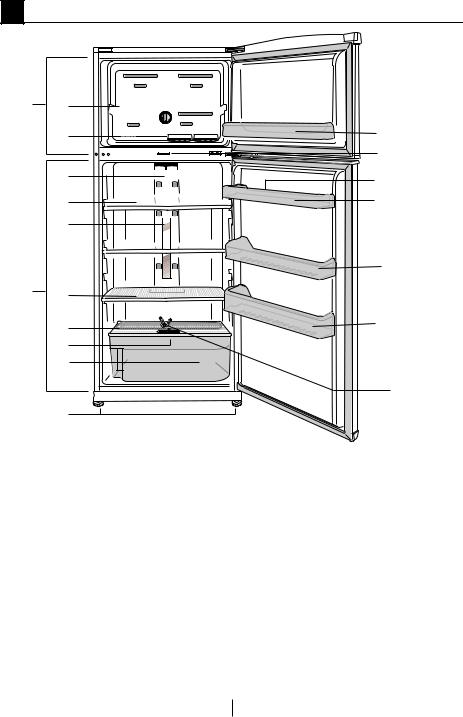
1 Votre réfrigérateur
141  *2
*2 











3 


*4 
5 
4 


154
6
*7
*8
9
10 *13 11 *12
12
*12
*13
1- |
Étagère du compartiment |
9- |
Pieds réglables |
|
congélation |
||||
10Etagère de la porte du compartiment |
||||
2- |
Appareil à glaçons |
|||
congélateur |
||||
3- |
Bouton de réglage de la température |
|||
11- |
Casier à œufs |
|||
du compartiment réfrigérateur |
12Etagère de la porte du compartiment |
|||
4- |
Étagères réglables |
|||
de réfrigération |
||||
5- |
Lentilles d'illumination |
|||
13- |
Verrouıllage |
|||
6- Couvercle du bac à légumes |
||||
14 |
Compartiment congélateur |
|||
7- Manette de contrôle d’humidité du |
||||
15- |
Compartiment réfrigérateur |
|||
bac à légumes |
||||
|
|
|||
8- |
Bac à légumes |
*EN OPTION |
||
|
|
|||
CLes illustrations présentées dans cette notice d’utilisation sont schématiques et peuvent ne pas correspondre exactement à votre produit. Si des pièces présentées ne sont pas comprises dans le produit que vous avez acheté, elles sont valables pour d’autres modèles.
3FR

2 Précautions importantes pour votre sécurité
Veuillez examiner les informations suivantes : Le non respect de ces consignes peut entraîner des blessures ou dommages matériels. Sinon, tout engagement lié à la garantie et à la fiabilité du produit devient invalide.
La durée de vie du produit que vous avez acheté est de 10 ans. Il s’agit ici de la période au cours de laquelle vous devez conserver les pièces de rechange nécessaires à son fonctionnement.
Utilisation prévue
Ce produit est prévu pour une utilisation
–en intérieur et dans des zones fermées telles que les maisons ;
–dans les environnements de travail fermées, tels que les magasins et les bureaux ;
–dans les lieux d'hébergement fermés,
tels que les fermes, hôtels, pensions.
• Cet appareil ne doit pas être utilisé en extérieur.
Sécurité générale
•Avant de vous débarrasser de votre appareil, veuillez consulter les autorités locales ou votre revendeur pour connaître le mode opératoire et les organismes de collecte agréés.
•Consultez le service après-vente agréé concernant toutes questions ou problèmes relatifs au réfrigérateur. N’intervenez pas ou ne laissez personne intervenir sur le réfrigérateur sans le communiquer au service après-vente agréé.
•Pour les produits équipés d'un compartiment congélateur :
ne mangez pas de cônes de crème glacée ou des glaçons immédiatement après les avoir sortis du compartiment de congélation ! (Cela pourrait provoquer des engelures dans votre bouche).
•Pour les produits équipés d'un compartiment congélateur : ne placez pas de boissons en bouteille ou en cannette dans le compartiment de congélation. Cela peut entraîner leur éclatement.
•Ne touchez pas des produits congelés avec les mains, ils pourraient se coller à celles-ci.
•Débranchez votre réfrigérateur avant de le nettoyer ou de le dégivrer.
•La vapeur et des matériaux de nettoyage pulvérisés ne doivent jamais être utilisés pour les processus de nettoyage ou de dégivrage de votre réfrigérateur. La vapeur pourrait pénétrer dans les pièces électriques et provoquer des courts-circuits ou des électrocutions.
•Ne jamais utiliser les pièces de votre réfrigérateur telles que la porte, comme un support ou une marche.
•N’utilisez pas d’appareils électriques à l’intérieur du réfrigérateur.
•N’endommagez pas les pièces où circule le liquide réfrigérant avec des outils de forage ou coupants. Le liquide réfrigérant qui pourrait s’échapper si les canalisations de gaz de l’évaporateur, les rallonges de tuyau ou les revêtements de surface
étaient percés, peut irriter la peau et provoquer des blessures aux yeux.
•Ne pas couvrir ou obstruer les orifices de ventilation du réfrigérateur.
4FR
